The Ubiquitous Helix
October 3, 2016
A
helix is a
curve in
three-dimensional space that's described by the simple set of
parametric equations,
x = a cos(t)
y = a sin(t)
z = bt
In this case,
a is the
radius of the
virtual cylinder on which the helix is wound, and the
slope of the curve at any
point is
b/a. A
right-hand helix is shown in the figure, and it's obvious how the equations can be modified to produce a left-hand helix.

A right-hand helix generated by the parametric equations shown.
(Created using Gnumeric and Gnuplot.)
Probably the most familiar helix is on a machine bolt. In this case, the helix is an
inclined plane, one of the
simple machines that include the
lever and the
pulley.
Renaissance mechanics considered the screw to be a simple machine, but the helical
thread, itself, is an inclined plane.
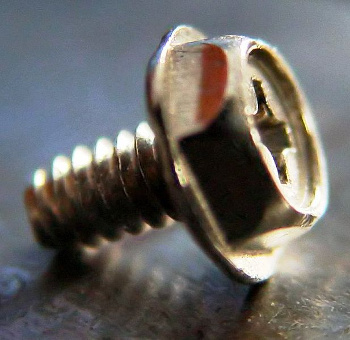
A machine bolt.
At this angle, it's not possible to determine which of the many cruciform head types this is.
In any case, I would use a socket wrench, since it's easier.
(Via Wikimedia Commons.)
Another common helical
artifact is the
coil spring. Springs can act in
compression (see figure),
tension, or
torsion. While it's difficult to observe this, springs function by torsion of their wire. When
designing a spring, the important
material property is the
shear modulus, not
Young's modulus.
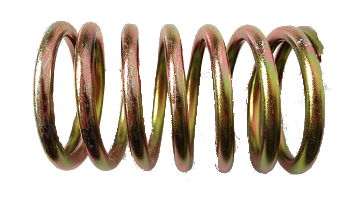
A compression spring.
(Wikimedia Commons image by Frank Müller, modified.)
Nature was making use of the mechanical properties of helices long before humans.
Cucumbers,
squash, and similar plants, have helical
tendrils that are attached to objects to elevate the leaves to regions with more sunlight. These tendrils are unusual in having a right hand helix on one end, and a left hand helix on the other, a fact noted in 1865 by Charles Darwin.

A tendril of an unidentified Cucurbitaceae-family plant.
The right hand helix can be seen below the upper left hand helix.
(Wikimedia Commons photo by Dirk van der Made, cropped.)
Darwin called the transitional region between these helices a "perversion." The word, perserion, in this case derives from the
Latin adjective, "perversus," which means slanted, crooked, or cross-eyed. I wrote about these tendrils, and a recreation of their properties in a
synthetic material, in two previous articles (
Twisty Cucumbers, All Alike, September 7, 2012, and
Let's Do The Twist, May 9, 2014).
A
biological helix,
DNA, is at the core of our being. In what's perhaps the
scientific understatement of the last
century,
James Watson and
Francis Crick wrote in their
paper presenting the double helix structure of DNA,
"It has not escaped our notice that the specific pairing we have postulated immediately suggests a possible copying mechanism for the genetic material."[1]
The two helices are composed of
sugar phosphates, and these are linked together by
molecules of
cytosine,
guanine,
adenine, and
thymine, Cytosine is always paired with guanine, and adenine is always paired with thymine.
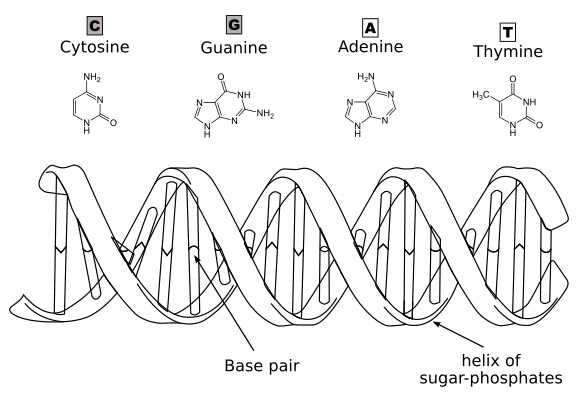
The double helix structure of DNA. (Modified Wikimedia Commons image. Click for larger image)
This article is an opportunity for me to mention my favorite
antenna, the
axial mode (end fire) helical antenna,
invented in 1946 by
John Kraus (1910-2004). Kraus built his
prototype antenna by winding a helix of seven turns of
copper wire with a 12
centimeter circumference, this being the
wavelength of his
signal source.[1] Helical antennas are used in many
high frequency applications, such as
satellite communication (see figure), and long distance
Wi-Fi communication.
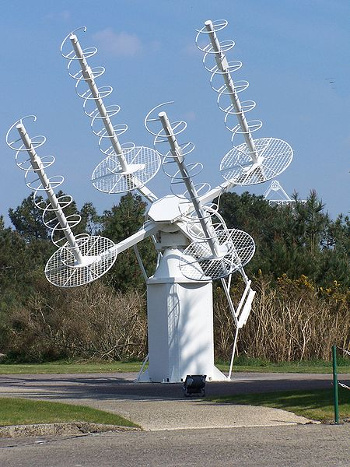
An array of helical antennas.
A typical helical antenna with ten spiral turns has a half-power beam width of about fifteen degrees.
Helical antennas are suitable for high frequency transmission and reception in the UHF band and higher. At lower frequencies (longer wavelengths), the antenna dimensions are quite large.
(Via Wikimedia Commons.)
The helix appears, also, in
architecture, and not just for
aesthetic reasons. Two examples of helical buildings are the
Turning Torso,
Malmö,
Sweden, and the
Cayan Tower,
Dubai,
United Arab Emirates, as shown in the figure. As you can imagine,
construction of such a building is more complicated than construction of a traditional
rectangular parallelpiped building, so why are such buildings being constructed?
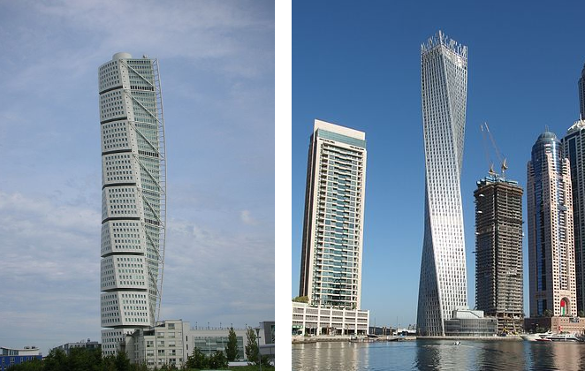
Two examples of helical architecture, the Turning Torso, Malmö, Sweden, and the Cayan Tower, Dubai, United Arab Emirates. (left image by Artico2, and right image (modified) by Guilhem Vellut, both via Wikimedia Commons.)
The answer relates to the
wind-loading on the structure, and a
force concept known to all first-year
physics students. When a force acts on a surface, the angle at which it acts is important. Maximum effect happens when the force acts
perpendicular to the surface, and it decrease as the
cosine of the angle with respect to the perpendicular. When wind hits a building face straight-on, there's a lot of force, but when it hits a glancing blow, there's very little force; so, a twisted surface has a reduced response to winds from any direction.
A helical design actually decreases construction
cost, since less material is needed to resist the wind. It's reported that the helical design for the
Shanghai Tower reduced wind load by 24%, and this allowed a $58 million saving in structural materials.[3] It's also reported that fifteen spiral buildings have been constructed in the past eleven years, and thirteen additional are under construction.[3]
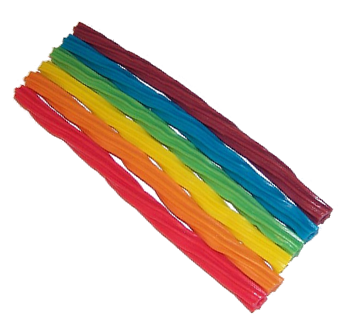
My favorite helical food, although various pastry twists come in as a close second.
(Via Wikimedia Commons.)
![]()
References:
- J.D. Watson and F.H.C. Crick, "A Structure for Deoxyribose Nucleic Acid," Nature, vol. 171, no. 4356 (April 25, 1953), pp. 737-738.
- J.D. Kraus, "Antennas," McGraw-Hill (New York, 1989), pp. 265f. (paperback edition, via Amazon).
- Meg Miller, "Charting The Rise Of A New Trend In Skyscraper Design," Fast Company, August 25, 2016.
Permanent Link to this article
Linked Keywords: Helix; curve; three-dimensional space; parametric equation; radius; virtual; cylinder; slope; point; right-hand rule; left-hand rule; Gnumeric; Gnuplot; machine bolt; inclined plane; simple machine; lever; pulley; Renaissance; classical mechanics; mechanic; thread; angle; cruciform head type; socket wrench; Wikimedia Commons; artifact; coil spring; compression; tension; torsion; design; material property; shear modulus; Young's modulus; Frank Müller; cucumber; Cucurbita; squash; tendril; leaf; leaves; sunlight; Charles Darwin; Cucurbitaceae; Dirk van der Made; Latin; adjective; esotropia; cross-eyed; chemical synthesis; synthetic; material; biology; biological; DNA; science; scientific; understatement; century; James Watson; Francis Crick; scientific literature; paper; gene; genetic; sugar phosphate; molecule; cytosine; guanine; adenine; thymine; antenna; axial mode (end fire) helical antenna; invention; invent; John Kraus (1910-2004); prototype; copper wire; centimeter; circumference; wavelength; signal source; radio spectrum; high frequency; satellite; communication; Wi-Fi; beam diameter; half-power beam width; degree; frequency; transmission; reception; ultra high frequency; UHF band; architecture; aesthetic; Turning Torso; Malmö; Sweden; Cayan Tower; Dubai; United Arab Emirates; construction; cuboid; rectangular parallelpiped; Guilhem Vellut; wind-loading; force; physics; student; perpendicular; cosine; cost; Shanghai Tower; pastry; rainbow licorice candy; J.D. Watson and F.H.C. Crick, "A Structure for Deoxyribose Nucleic Acid," Nature, vol. 171, no. 4356 (April 25, 1953), pp. 737-738.